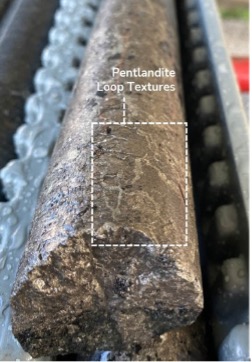Ero Copper Corp. (TSX: ERO) has discovered a regional nickel sulphide system within the Curaçá Valley in Brazil over an initial strike length of five km.
The system remains open in all directions and is highlighted by multiple surface expressions of nickel mineralisation.
Results from first-pass drilling conducted on two of the identified zones along the currently interpreted northeast and southwest boundaries of the system are highlighted by:
VB Zone
- VB-17: 16.5 m at 1.22% Ni, 0.17% Cu and 0.03% Co (1.37% NiEq), including 3.8 m at 3.60% Ni, 0.22% Cu and 0.09% Co (3.92% NiEq)
- Interval includes 1.5 m of massive-sulphide textures (~80% sulphides) grading 6.59% Ni, 0.26% Cu and 0.17% Co (7.11% NiEq)
- VB-25: 30.4 m at 0.63% Ni, 0.12% Cu, 0.02% Co (0.72% NiEq), including 5.1 m at 2.06% Ni, 0.25% Cu, 0.05% Co (2.28% NiEq)
- Interval includes 1.4 m of massive-sulphide textures (~60% sulphides) grading 4.94% Ni, 0.14% Cu, 0.12% Co (5.30% NiEq)
Lazaro (LZ) Zone
LZ-03: 24.1 m at 0.81% Ni, 0.18% Cu and 0.04% Co (0.97% NiEq), including 13.0 m at 1.11% Ni, 0.25% Cu and 0.05% Co (1.33% NiEq)
LZ-06: 22.5 m at 0.84% Ni, 0.15% Cu and 0.05% Co (1.02% NiEq), including 8.0 m at 1.34% Ni, 0.25% Cu and 0.07% Co (1.61% NiEq)
LZ-07: 17.7 m at 0.93% Ni, 0.21% Cu and 0.05% Co (1.14% NiEq), including 5.0 m at 1.15% Ni, 0.20% Cu and 0.06% Co (1.38% NiEq)
The newly discovered nickel system, known as the “Umburana System”, is located approximately 20 km from the company’s existing Caraíba processing facilities. The system was discovered using new detailed field mapping and soil geochemistry collected during the company’s 2021 and 2022 exploration programmes in conjunction with the company’s airborne electromagnetic (AEM) survey.
First-pass drilling comprised of 48 drill holes initially testing where ultramafic rocks have been mapped at surface.
The ongoing programme has identified large intervals of disseminated and interstitial nickel sulphides as well as zones of high-grade semi-massive (containing approximately 30% to 60% sulphides) and massive sulphides (containing approximately 60% to 80% sulphides), with massive sulphide intercepts up to 1.5 m in thickness grading up to 6.59% nickel (7.11% NiEq).
Nickel mineralisation outcrops at surface, is evident in trenches and remains open down-plunge. Maximum depth of drilling to date is approximately 300 meters below surface. There are four exploration drill rigs currently operating on the system.
“This is a significant and pivotal moment for the company and, more broadly, for the region,” CEO, David Strang, said.
“To think that copper in the Curaçá Valley was first documented in the late 1700s and we are just now discovering nickel sulphide mineralisation not far from where copper has been mined for over 40 years is truly remarkable.
“As a company, we have been working to better understand the potential for nickel occurrences since first observed within the Vermelhos Mine in 2018. With newly compiled datasets, dedicated resources focused exclusively on understanding and finding nickel and a complete re-look of several historic datasets this past year, our efforts and persistence have paid off. We believe today’s results confirm the Curaçá Valley’s potential to be a globally significant magmatic sulphide district for both copper and nickel.”
For further information please visit: https://erocopper.com/












